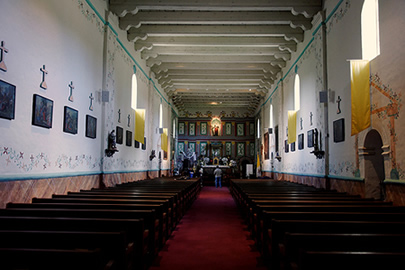

American Latino Heritage
Mission Santa Inés
California
 |
Mission Santa Inés circa 1900. |
Father Estévan Tapís, president of the California mission chain, founded Mission Santa Inés. The site chosen for the mission was at a midway point between Mission Santa Barbara and Mission La Purísima Concepción. Its purpose was to relieve overcrowding at those two missions and to serve the Indians living east of the Coast Range.
Construction on Mission Santa Inés began in 1804 with one row of buildings. This wing contained the temporary church, a sacristy, the padres' quarters and the granary. The 30-inch thick walls were made of adobe and the roof consisted of poles covered by sticks laid side by side, and then by a layer of adobe soil that hardened, thus sealing out the weather. On September 17, 1804, Father Tápis officially dedicated the mission to Saint Agnes constructing a temporary brushwood shelter at which 200 Indians attended solemn High Mass. By the end of 1804, the baptismal register already contained the names of 112 Chumash converts of all ages.
An 1812 earthquake near Santa Barbara destroyed most of the original church, part of the division wall, and the bell tower. Many of California’s missions suffered damage, destruction, and even abandonment during this disaster. Santa Inés built a temporary church to sustain the mission er during its reconstruction. Despite the natural disaster, Mission Santa Inés reached its peak in 1816 with a population of 786 baptized Native Americans. Dedicated on July 4, 1817, the new church and bell tower still stand today.
 |
Inside the Mission Santa Inés |
The mission is also important as the place where the Chumash Revolt of 1824 started, one of the largest and most successful revolts of American Indian Catholic neophytes in the Spanish West that reflected indigenous resistance to European colonization. After Mexican Independence from Spain in 1821, life at the California missions changed. The Chumash were forced to work for the Mexican army, receiving payment in IOUs, which caused mounting frustration. On February of 1824, the beating of a Chumash by a Santa Inés soldier sparked an armed revolt that rapidly spread. Fires destroyed many Santa Inés buildings and smoke damaged paintings and decorations in the sanctuary. The large insurrection spread outside of Santa Inés to other missions in Alta California. After the restoration of peace and the punishing of the instigators of the rebellion, baptisms resumed, but the heyday of Santa Inés was over.
Another consequence of Mexico’s independence was secularization, which led to the decline of mission life. In 1834, the Mexican Assembly passed the Secularization Laws, which shifted responsibility for mission temporalities from the church to the government. The new laws confiscated the mission lands, produce, and animals and placed them under the administration of local Mexican ranch owners. The mission priests were allowed a small parcel of land for their use and to administer to the spiritual needs of the remaining neophytes. All priests had to take an oath of allegiance to the Mexican government, and those who remained loyal to Spain were deported to Spain. The mission churches became parish churches administering to the spiritual needs of the growing settler population. Ultimately, secularization caused the departure of the Spanish missionaries and most of the Chumash neophytes, and the eventual decline of Mission Santa Inés.
 |
Mission Santa Inés today |
In August of 1989, the 18th annual Fiesta celebrated many years of hard work. Particularly important to the Fiesta was the reconstruction of 8 of the 19 arches that form the eastern façade of the building. This restoration recreated the appearance of the convento prior to secularization in 1834. The new portion of the convento building now houses a large parish hall complete with kitchen and two conference rooms. All are used by the parish as well as area groups for meetings. Inside the hall are several large paintings done by local artists depicting the various eras of mission life as well as the present life of the parish. Restoration work begun on the mission paintings in 1992 is ongoing.
Today, the Mission Santa Inés District consists of 15 buildings, structures, and sites that reflect the period between 1804 to 1855, when local Chumash lived in one of Spain's and then Mexico's primary colonizing institutions. Surviving historic buildings include the massive original adobe (mud brick) church and convento (priests' residence) wing. archeological remains of the original padres' (priests) residences, the Chumash village of both traditional and adobe dwellings, the soldiers' residence, the temporary church, and the ecclesiastical college of 1844-1868. The mission also has a largely intact water system with plaza and village lavanderias (washing areas), the site of the mission garden, and a complex of reservoirs and mills.
| Plan your visit |
Mission Santa Inés, a National Historic Landmark, is located at 1760 Mission Dr. in Solvang, CA. Click here for the National Historic Landmark registration file: text and photos. The mission offers self-guided and audio tours of the museum and gardens daily from 9:00am to 4:30pm, and is closed on Easter, Thanksgiving, Christmas, and New Year’s Day. Admission is $5.00 for adults and free for children under 11. For more information, visit the Mission Santa Inés website or call 805-688-4815. |